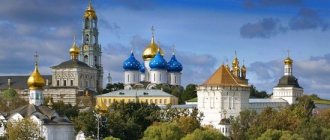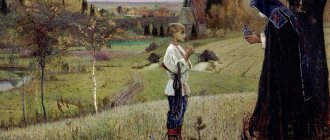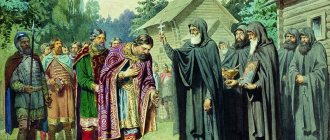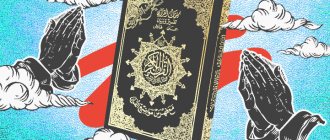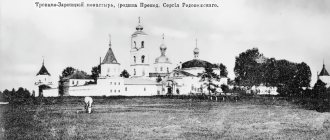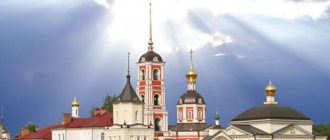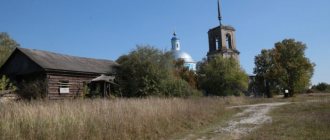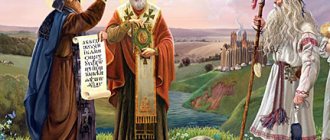Many centuries ago, in a family of wealthy boyars, Cyril and Maria had a boy named Bartholomew. He grew up in the village of Varnitsy near Rostov. At the age of 7, his parents sent him to study. But it turned out that Bartholomew was not good at reading. No matter how hard he tried, the letters did not form words.
One day, in sadness, he ran away to the meadow where the cows were grazing and began to cry bitterly, because he tried, but he couldn’t read. So wandering through the meadow he met a wanderer. This was an old man traveling around the world. He asked the boy for something to eat. Bartholomew took him to his mother and she fed the wanderer. Mom asked him what new things he learned at school and the son admitted that he could not learn to read. Then the wanderer smiled tenderly and offered to read him a prayer. To his mother’s surprise, Bartholomew read the prayer without difficulty and from then on began to read perfectly. And most of all, he was fascinated by sacred texts and fell in love with prayers with all his soul.
When the boy was 12 years old, his parents moved to the city of Radonezh. There the boy began to study even more diligently and devoted more and more time to fasting and tireless prayer. After the death of their father and mother, the saddened Bartholomew and his older brother Stefan went into the forest where they built a small church to pray for their deceased father and mother.
Soon Bartholomew decided to become a monk and took monastic vows. When he was ordained a monk, he was given a new name, Sergius, and since he lived at that time not far from the city of Radonezh. Everyone began to call him Sergius of Radonezh. And soon the small church built by Sergius and his brother Stefan turned into a monastery.
Sergius had disciples, and he himself became abbot. Among the ruling princes at that time, Sergius was a very respected person; he easily reconciled rulers who had quarreled among themselves and not only, and also prayed for the soldiers to bring victory to their commanders. Dmitry Donskoy came to Sergius asking for help and prayer before the Battle of Kulikovo and won. Sergius knew how to heal deadly diseases and treated terminally ill people with herbs and prayer. He built more than one temple during his lifetime, and what was once a small church turned into a beautiful and prosperous monastery. Which sheltered within its walls a huge number of people in need of help.
Sergius left only his beloved student near him before his death. He predicted his imminent death and told his disciples not to be sad. When his strength began to fail him, he took a vow of silence and did not utter another word. After his death, Sergius began to be revered by the Russian Orthodox Church as a saint. During his lifetime, he performed many good deeds, and miraculous healings were not uncommon. Military men pray to the saint asking for victory and protection in battle. And asking for healing from various ailments.
Menu
Sergius of Radonezh (before becoming a monk - Bartholomew Kirillovich) Russian church and political figure. Born into a boyar's family not far from Rostov. The family, suffering from Tatar exactions and princely strife, moved to the Moscow principality and received land near the city of Radonezh.
At the age of seven, Bartholomew was sent to learn to read and write. He wanted to study with all his heart, but literacy was not given to him. According to legend, Bartholomew suffered greatly from this and therefore he prayed to God day and night to open the door of bookish understanding to him. One day, while looking for missing horses in a field, he saw an unfamiliar old man under an oak tree. The monk prayed. The boy approached him and told him about his grief. Having listened sympathetically to the boy, the elder began to pray for his enlightenment. Then, he took out a small piece of bread and said: “Take it and eat it: this is given to you as a sign of the grace of God and the understanding of the Holy Scriptures.” This grace really came to the child: the Lord gave him memory and understanding, and he began to easily assimilate book wisdom. After this miracle, the desire to serve only God grew stronger in young Bartholomew. He wanted to retire, following the example of the ancient ascetics, but his love for his parents kept him in his family.
After the death of his parents, Bartholomew provided an inheritance to his younger brother Peter and, together with his older brother Stefan, settled 10 miles from Radonezh, in a deep forest near the Konchyura river. The brothers cut down the forest with their own hands and built a cell and a small church. This is how the famous monastery of St. Sergius arose. Soon Stefan left his brother and became the abbot of the Epiphany Monastery in Moscow and the confessor of the Grand Duke. Bartholomew became a monk and was given a new name - Sergius. For about two more years he lived alone in the forest.
The fame of the great recluse spread throughout Rus'. People flocked to the monastery. Soon, Sergius of Radonezh, together with his elder brother Stephen (around 1330-40), founded the Trinity Monastery (Trinity-Sergius Lavra) and became its second abbot.
Sergius introduced a communal charter in the monastery, destroying the previously existing separate residence of monks. The adoption of the communal charter and its subsequent distribution, with the support of the grand ducal authorities, the Russian metropolitan and the Patriarch of Constantinople, to other monasteries in North-Eastern Rus' was an important church reform that contributed to the transformation of monasteries into large economic and spiritual centers.
Sergius's moral authority, close ties with the family of Grand Duke Dmitry Ivanovich Donskoy, the most prominent boyars and highest church hierarchs allowed Sergius of Radonezh to actively influence the church and political affairs of his time. In 1380, he helped Dmitry prepare for the Battle of Kulikovo, and in 1385 he resolved his conflict with the Ryazan prince Oleg.
The Monk Sergius died on September 25, 1392. He was buried in the monastery he founded; canonized by the Russian Church.
Sergei Radonezhsky - his life and exploits
Sergius of Radonezh is a hieromonk of the Russian Church, the founder of a number of monasteries, including the Holy Trinity Monastery, a reformer of monasticism, who had a huge influence on Russian spiritual culture. After his death he was canonized.
Sergius of Radonezh, in the world Bartholomew, was born on May 3, 1314 in the Rostov principality, in the village of Varnitsa. Unlike his two brothers, Bartholomew studied very poorly and was unable to read and write. When the boy learned to write and read, he showed great interest in the Holy Scriptures and the church. At the age of twelve, Bartholomew began to strictly fast and pray a lot and earnestly.
Around 1328, Bartholomew's family, fleeing poverty and regular Tatar raids, was forced to move to Radonezh. By this time, the boy had already decided to take monastic vows. The parents were not against this, but asked their son to do it after their death. The matured brothers had already started their own families, and Bartholomew was the only support for his elderly parents. After their death, Bartholomew and his widowed elder brother Stefan took monastic vows and went to deserted places, building a small temple in the forest in honor of the Holy Trinity. Soon Stefan, unable to withstand the excessively harsh life in the forest, went to the monastery, leaving his brother alone in the forest.
In 1337, Bartholomew called Abbot Mitrofan and took monastic vows, becoming monk Sergius. Soon monks began to come to him, and a monastery was founded on the site of the temple. Sergius became the second abbot of the monastery, and the first was Abbot Mitrofan. The abbots set an example of true humility and great hard work for their students. Sergius of Radonezh never took alms from parishioners and forbade monks to do this, urging them to live only by their own labors.
The fame of the monastery and its abbot expanded and soon reached the city of Constantinople. Having learned about Sergius of Radonezh, Ecumenical Patriarch Philotheus sent ambassadors to him with gifts and a letter, in which he paid tribute to his exemplary activities.
The Monk Sergius enjoyed great respect not only among monks and common people, but also among princes. The rulers turned to him for blessings before decisive battles and asked for advice on difficult issues. The meek, humble Sergius of Radonezh could find his way to the heart of anyone, even the most rude and bitter person. More than once he had to reconcile warring parties. Sergius constantly called on the Russian princes to unite, because he understood that only in this way could the Slavic people grow stronger and get rid of the hated Tatar-Mongol yoke.
During his lifetime, Sergius of Radonezh founded several more monasteries: Blagoveshchensky, Borisoglebsky, Staro-Golutvinsky, Georgievsky, Vysotsky, Andronnikova and Simonov. He performed many miracles, including the repeated healing of seriously ill people and even the resurrection of a boy.
The great hieromonk died on September 25, 1392. In 1452, Sergius of Radonezh was canonized. In front of his icon, believers ask for speedy relief from illnesses; he is considered the patron saint of all students.
Resurrection of a boy
The Life of Saint Sergius tells that the saint once resurrected a man with his prayers. This was a boy whose father, a devout believer, carried his sick son through the cold so that Saint Sergius would heal him. The man’s faith was strong, and he walked with the thought: “If only I could bring my son alive to the man of God, and there the child will definitely recover.” But due to the severe frost and the long journey, the sick child became completely weak and died on the road. Having reached Saint Sergius, the inconsolable father said: “Woe is me!” Ah, man of God! With my misfortune and tears, I hurried to get to you, believing and hoping to receive consolation, but instead of consolation I only acquired even greater sorrow. I would have been better off if my son had died at home. Woe is me, woe! What to do now? What could be more bitter and terrible than this? Then he left the cell to prepare a coffin for his child. Sergius of Radonezh prayed for a long time on his knees with the deceased, and suddenly the child came to life and began to move, his soul returned to his body. The saint told the returning father that the child had not died, but was only exhausted from the frost, and now, in the warmth, he had warmed up. This miracle became known from the words of the saint’s disciple.
Victories over demons and taming animals
At first, he constantly struggled with demonic temptations, defeating them with fervent prayer. Demons tried to drive him out of the forest, threatening him with an attack by wild animals and painful death. The saint remained adamant, called on God and thus was saved. He also prayed when wild animals appeared, and therefore they never attacked him. The saint shared every meal with the bear, so often depicted next to Sergius, and sometimes even gave it up to the hungry animal. “Let no one be surprised at this, knowing truly that if God lives in a person and the Holy Spirit rests on him, then all creation submits to him,” says the life of this saint.
Flowsheet Templates
Task 1. In order to better learn about St. Sergius of Radonezh, we will play a game. To do this, students must be divided into two teams.
Next, the teacher asks questions, and whose team answers the most questions will be the winner. For a correct answer, the team gets one point.
Task 2. Next, the team reads the poem expressively; whose team reads the poem better will be considered the winner.
Task 3. Each team must give an example from the life of St. Sergius. For this you can use folk proverbs.
Task 4. Stage a mini-scene in which the heroes are students. Let the text serve as a short story about the life of Sergius of Radonezh.
Brief story about the life of Sergius of Radonezh
A story about the life of Sergius of Radonezh.
There are people in the history of Russia whose lives became an example of selflessness for the sake of an idea, such as Sergius of Radonezh.
Today it is important to understand the significance of a figure for the Fatherland, an unusually patient, modest and hardworking person. He rose to the unattainable heights of holiness, remaining in the shadows, remaining second, truly being first. The Venerable Elder Sergius was born in the Tver Principality, into the well-behaved boyar family of Cyril and Maria. Even before birth, the baby in the womb made itself known by screaming during a service in the temple. This prompted the parents to make a vow that if a boy was born, then he would be a servant of God. So, that’s how it worked out. The boy was born and received the name Bartholomew at baptism. The teenager, who had been sent to learn to read and write, lagged behind his peers and was very worried about it. One day in a field, under an oak tree, he met a priest and told him about his weakness. The priest promised the boy that everything would improve, and he would surpass his peers in his studies. Years later, Bartholomew began to pray and fast so earnestly that his frightened mother tried to persuade him to lighten his labors a little, but to no avail. After the death of his parents, the boy and his brother Stefan retired to the Radonezh forest, preparing for tonsure. In these places, Bartholomew took monastic orders and became Sergius; here he managed to deal with a bear that ate bread from his hand and performed various miracles. The fame of the monk's exploits spread throughout Rus', and pilgrims flocked to him from all over the world; many settled near the monastery, which soon turned into a monastery. Sergius, who became abbot, did not stand out from the brethren, carrying out ordinary obediences, like a simple monk. The example of the moral life of a monk gained Sergius wide fame. Everyone listened to his words, regardless of their position in society. On the eve of the Battle of Kulikovo, the Grand Duke of Moscow Dmitry asked the elder for his blessing for the battle. Sergius, in addition to blessing, sent two of his monks with the prince: Oslyabya and Peresvet. Inspired by the blessing of Sergius, the army of Prince Dmitry, who later began to be called Donskoy, completely defeated the Tatar army. For another 20
years after the significant battle, Sergius of Radonezh lived, nourishing the spirit of the Russian people who laid the foundation of the great state. He pacified the ardor of angry princes, keeping them from bloody strife. Sergius left a charter for the monastery, which was later adopted by other Russian monasteries. Where the monk once retired, now rise the domes of the Trinity-Sergius Lavra, overshadowed by divine grace. The founder of the monastery, Sergius of Radonezh, is still considered the heavenly patron of Rus'.
Feat of modesty
The Monk Sergius of Radonezh could have become a metropolitan, a bishop, but he refused to even become the abbot of his monastery. He asked Metropolitan Alexy of All Rus' to appoint an abbot to the monastery, and, hearing his name in response, did not agree, saying: “I am not worthy.” Only when the Metropolitan reminded the saint of monastic obedience did he answer: “As the Lord wills, so be it. Blessed be the Lord forever!” However, when Alexy was dying and offered Sergius to become his successor, he refused. The saint repeated his refusal after the death of the metropolitan, all with the same words: “I am not worthy.”
St. Sergius of Radonezh creative work of students in the Russian language (4th grade) on the topic
Venerable Sergius of Radonezh
The Russian saint Sergius of Radonezh is one of the great people, who went down in history as the smartest and wisest person.
His name has been familiar to me for a long time, since I go to Sunday school at the Alexander Nevsky Church, located in the city of Kirov, and have repeatedly turned to him for help in learning, overcoming fear and uncertainty. And recently, in a literary reading lesson, we studied “The Life of Sergius of Radonezh.” The Life was written by Epiphanius the Wise. Thanks to this, the name of Sergius of Radonezh was preserved in people's memory. I learned a lot of interesting things from the life of the saint. And I wanted to read even more about him.
Saint Sergius of Radonezh was given the name Bartholomew at baptism. I was surprised and amazed that even before birth, while in the womb, he screamed loudly three times. And then, as a baby, he did not take his mother’s breast on Wednesday and Friday, since these days are fasting in the Orthodox religion. And when he grew up and was sent to study, he could not learn to read, and he was not even able to learn letters. And then one day he met the holy elder and complained to him that he was not being given a diploma. The elder gave Bartholomew a piece of prosphora. Having tasted it, the boy gained the gift of understanding literacy and began to read books and sing psalms. Three miracles that happened to the child indicate that he was chosen by God. And I believe in it. God sends such people into the world in order to sow goodness, justice, and strength of spirit.
The scientific literature does not indicate the exact date of birth of the Saint. But it is known that he was born in the 14th century and came from a noble family. His parents, Kirill and Maria, lived on their estate near Rostov. In addition to Bartholomew, they had two more sons - Stefan and Peter. Their family was pious. From an early age, in church and at home, the boy heard prayers and easily remembered them. But he was very different from his brothers and peers. Bartholomew was a meek, silent and humble boy. He did not like noisy games; he sat alone in the garden for hours and thought about something.
When Rostov was devastated after another Tatar raid, Father Kirill was forced to seek service with the Moscow Tsar, and he was assigned to serve in the city of Radonezh.
Bartholomew, at a young age, decided to take monastic vows. Having become an adult, he and his older brother Stephen left home to renounce worldly life and submit to the will of God. They spent several years in a secluded place. The brothers built a wooden cell and a small church in the name of the Holy Trinity. But the brother could not stand the difficulties of life in a deserted place and left the Moscow Epiphany Monastery. But Bartholomew remained and later took monastic vows under the name Sergius. He became a solitary monk. Solitude, silence, silence, cold and malnutrition did not frighten him. In such an environment he thought well. All his time was occupied by kneeling at night prayers and working in a small vegetable garden. These were years of complete loneliness and struggle with dark forces that required him to strain his spiritual and physical strength. He emerged victorious from this struggle, thereby accomplishing a spiritual feat.
After several years, people began to come there, ready to endure difficulties. So the desert turned into a monastery. After some time, Sergius was ordained a priest and became abbot of the new Trinity - Sergius Monastery.
People came to him for advice, blessings and prayer, and he helped them. The rumor about Sergius spread far beyond the monastery. The image of an ascetic, a miracle worker began to take shape around Sergius.
Sergius of Radonezh lived during the Tatar yoke. By the example of his life, he raised the spirit of the Russian people and inspired faith in God's help. Many times he reconciled warring princes, advocating a peaceful solution to any problems. He convinced them to unite to fight a common enemy to defend Orthodoxy and the independence of Rus'.
Sergius denied any violence. But when Prince Dmitry arrived to him before the battle with Mamai, Sergius of Radonezh not only blessed him for a military performance, but, in addition, sent the monks-heroes Peresvet and Oslyabya with the prince. Thus, he showed that the cause of liberation of the Motherland is sacred even for those who have left worldly life.
Sergius of Radonezh predicted victory for Grand Duke Dmitry, and this prophecy came true. Russian soldiers won the battle on the Kulikovo Field, marking the beginning of the liberation of the Russian land from the Tatar yoke.
Sergius's contribution to the fate of Russia was appreciated by generations, and therefore he was canonized.
Sergius of Radonezh died on September 25, 1392. The Orthodox Church annually honors the memory of the saint. Anticipating his death, he handed the abbot's staff to his beloved student.
For Russian people, Sergius of Radonezh became an example of a righteous life, virtue, and inexhaustible fortitude. Therefore, to this day, thousands of people come to the Trinity - Sergius Lavra to venerate St. Sergius.
I want as many people as possible to turn to Saint Sergius for help, and then the world will become kinder, cleaner, more righteous. He will show you the path of forgiveness and love for your neighbor.
LiveInternetLiveInternet
Quote message clear
Read in full In your quotation book or community!
The exploits of Sergius of Radonezh
On October 8, the Orthodox Church honors the memory of St. Sergius of Radonezh. Sergius of Radonezh is truly a national saint, close to every Orthodox person. Let us remember his 7 exploits, strengthening faith and inspiring its deeds.
1
VICTORY OVER DEMONS AND TAMING BEASTS
The Monk Sergius seems to many to be a blessed old man, whose holiness was felt by the wild animals who came to “touch” her. However, in fact, Sergius went into the forest as a young man at the age of about twenty. At first, he constantly struggled with demonic temptations, defeating them with fervent prayer. Demons tried to drive him out of the forest, threatening him with an attack by wild animals and painful death. The saint remained adamant, called on God and thus was saved. He also prayed when wild animals appeared, and therefore they never attacked him. The saint shared every meal with the bear, so often depicted next to Sergius, and sometimes even gave it up to the hungry animal. “Let no one be surprised at this, knowing truly that if God lives in a person and the Holy Spirit rests on him, then all creation submits to him,” says the life of this saint.
2
BLESSING OF THE MONKS FOR WAR
This event is one of the most famous and most unexpected in the history of the Holy Trinity Sergius Lavra. Everyone knows that monks and weapons, and especially war, are “two incompatible things,” but, like any too broad rule, this rule was once refuted by life. Two monks, later canonized, went to the Battle of Kulikovo with arms in hand with the blessing of St. Sergius. In single combat before the battle, one of them, Alexander Peresvet, defeated the Tatar hero Chelubey, and this determined the victory of the Russian army. Peresvet himself died in the process. The second monk, tonsured Andrei (Oslyabya), according to legend, dressed in the armor of Prince Dmitry, killed in the battle, and so led the army. It is surprising that Sergius of Radonezh himself “sent” Peresvet and Oslyabya to the great battle to help Prince Dmitry, who asked the saint only for spiritual help. Before the battle, he tonsured the monks into the great schema.
3
PRESENT PARTICIPLE
The evidence of how St. Sergius of Radonezh received communion was hidden from people until his dormition. This secret was kept by Simon, a disciple of the saint, who had a vision during the communion of St. Sergius of Radonezh at the liturgy. Simon saw fire walking along the holy altar, illuminating the altar and surrounding the Holy Table on all sides. “When the Reverend wanted to take communion, the Divine fire coiled up like some kind of shroud and entered the holy chalice, and the Reverend took communion with it. Seeing all this, Simon was filled with horror and trembling and remained silent, marveling at the miracle...” The monk understood from the face of his disciple that he had been granted a miraculous vision, and Simon confirmed this. Then Sergius of Radonezh asked him not to tell anyone about what he saw until the Lord took him away.
4
RESURRECTION OF A BOY
The Life of Saint Sergius tells that the saint once resurrected a man with his prayers. This was a boy whose father, a devout believer, carried his sick son through the cold so that Saint Sergius would heal him. The man’s faith was strong, and he walked with the thought: “If only I could bring my son alive to the man of God, and there the child will definitely recover.” But due to the severe frost and the long journey, the sick child became completely weak and died on the road. Having reached Saint Sergius, the inconsolable father said: “Woe is me!” Ah, man of God! With my misfortune and tears, I hurried to get to you, believing and hoping to receive consolation, but instead of consolation I only acquired even greater sorrow. I would have been better off if my son had died at home. Woe is me, woe! What to do now? What could be more bitter and terrible than this? Then he left the cell to prepare a coffin for his child. Sergius of Radonezh prayed for a long time on his knees with the deceased, and suddenly the child came to life and began to move, his soul returned to his body. The saint told the returning father that the child had not died, but was only exhausted from the frost, and now, in the warmth, he had warmed up. This miracle became known from the words of the saint’s disciple.
5
FEAT OF HUMILITY
The Monk Sergius of Radonezh could have become a metropolitan, a bishop, but he refused to even become the abbot of his monastery. He asked Metropolitan Alexy of All Rus' to appoint an abbot to the monastery, and, hearing his name in response, did not agree, saying: “I am not worthy.” Only when the Metropolitan reminded the saint of monastic obedience did he answer: “As the Lord wills, so be it. Blessed be the Lord forever!” However, when Alexy was dying and offered Sergius to become his successor, he refused. The saint repeated his refusal after the death of the metropolitan, all with the same words: “I am not worthy.”
6
BREAD FOR MOSCOW
In besieged Moscow, many Orthodox Christians one day saw a completely gray-haired old man leading twelve carts with bread. No one could understand how this procession made its way through the impregnable guards and many enemy troops. “Tell me, father, where are you from?” - they asked the elder, and he joyfully answered everyone: “We are warriors from the monastery of the Most Holy and Life-Giving Trinity.” This elder, whom some saw and others did not, inspired Muscovites to continue the struggle and assured them of victory. And in the monastery of the miracle worker they said that the appearance of the elders in Moscow with bread was on the day when the Reverend appeared in the monastery to the sexton Irinarch and said: “I sent three of my disciples to Moscow, and their arrival will not go unnoticed in the reigning city.”
7
THE TOPPED KING
The Grand Duke of All Rus' Ivan Vasilyevich and Grand Duchess Sophia had three daughters, but did not have an heir. Christ-loving Sophia decided to go on a pilgrimage - on foot to the Trinity-Sergius Lavra from Moscow itself to pray for the birth of sons. Near the village of Klementyevo, located not far from the monastery, she met a magnificent priest with a baby in her arms. Sophia immediately understood from the appearance of the wanderer that in front of her was St. Sergius. Further, the life tells: “He approached the Grand Duchess - and suddenly threw the baby into her bosom. And immediately he became invisible.” Sophia reached the holy monastery and prayed there for a long time and kissed the relics of the saint. And upon returning home, she conceived in the womb the God-given heir to the royal throne, Grand Duke Vasily, who was born on the Feast of the Annunciation and was baptized in the Trinity-Sergius Lavra.
